
Wine Culture and Information since 2002 - Volume 22
 Wine Culture and Information since 2002 - Volume 22 |
|
Issue 124, December 2013 |
Contents |
|
|
Happy Birthday, Maestro Giacomo Tachis! |
|
On November 4th, Giacomo Tachis turned 80. A life dedicated to study and wine, the great Piedmontese wine maker has marked - more than every one else - the renaissance of Italian wine and its success all over the world. Giacomo Tachis, after a long and extraordinary career of wine maker, in 2010 retired from the world of wine or, better to say, to the active scene of vineyard and wineries. He however plays a role of absolute and indisputable importance, nevertheless, for the huge heritage and the immense wine making wealth that, with his talent, has given to Italy. I am not afraid of being denied: if today Italian wine has reached the highest successes in the world, this is because - undoubtedly - of the work of Giacomo Tachis and his wines that, being the first ones in this, have been capable of competing with the best wines in the world. A competition and a comparison that, most of the times, has seen his wines as strong and indisputable winners and, with them, Italy as well. Giacomo Tachis has turned 80 and, in this occasion, I am very glad to personally wish him happy birthday, while admitting in the past I frequently thought about writing a report about this magnificent protagonist of the Italian wine. Unfortunately, I never had the chance to personally meet Giacomo Tachis, but I however always had appreciated his wines which I had so many occasion to taste and appreciate. Listing the wines born from the genius and the deep knowledge of Giacomo Tachis would certainly be repetitive, “sons” so renowned in Italy and in the world everyone knows about. A worldwide success which brought Italian enology to the Olympus of Bacchus, rediscovering and reevaluating many autochthonous varieties of Italy, also with the help of some international grapes. Not so bad, for someone who has always been jokingly defined himself a “wine blender”, despite his remarkable knowledge, culture and competence everyone recognize to him. A man ahead of his time at least of twenty years, Giacomo Tachis had the willingness and the right vision of what would have become Italian wine in the following years: his influence is still strong nowadays. The great Piedmontese wine maker has in fact contributed to the development of Italian wine, also by reevaluating many Italian varieties which were, before of his work, almost abandoned and underrated. Carignano and Nero d'Avola are just two of the many examples which can be provided and, in these two specific cases, have also marked the strong development of enology in Sardinia and Sicily. Tuscany too is a region owing Giacomo Tachis a good part of its present splendor and success. Here he has been capable of exalting the remarkable potentials of the territory, by creating wines that - still toady - are indisputable representatives of Italian wines in the world. Likewise, in the Marches he has been successful in blending Cabernet Sauvignon and Merlot to the local Montepulciano. The history of Giacomo Tachis is amazing and fascinating, rich of successes that, undoubtedly, were not achieved by chance or because of a benevolent fate. A man of deep viticultural and wine making knowledge, Giacomo Tachis is also a remarkable scholar and has a deep knowledge about the history of wine and of the Italian territory. A fascinating account of his life and of his extraordinary career of wine maker and man of wine, can be read on his autobiography Sapere di Vino (Knowledge of Wine) - in Italian language - a book I suggest everyone to read. This book is rich in information and wine making philosophy, it also offers a significant vision of the history of Italian wine in the last fifty years. Here, Giacomo Tachis writes about his collaboration with the great French wine maker Émyle Peynaud, one of the indisputable fathers of modern wine making, a role - with no doubt - also represented by Giacomo Tachis as well. Graduated in 1954 at the famous Scuola Enologica di Alba (Enology School of Alba), Giacomo Tachis is one of the few figures who witnessed the rebirth and the relaunch of Italian wine, not only as spectator, but, first of all, as an indisputable and fundamental main actor. In 1961 the fundamental step which will begin his extraordinary career and, with that, the beginning of the modern history of Italian wine. Everything begins in Tuscany, the region where Giacomo Tachis understood Italian wine was certainly capable of changing its status of mediocrity and to challenge the world. Challenging the world and win. This how it was and the results arrived very soon: in just ten years, the great Piedmontese wine maker gave life to prestigious and refined wines, in particular, of great quality. A worldwide success, wines defined as Super Tuscans by the foreign press, as they were so different and distant from what Tuscany used to make at those times. This could also be, maybe, because of what the market was asking at those times - different wines from what was produced in Italy in that period - Giacomo Tachis has however been successful in his intent: to show it was possible to make quality wine. He was the first to prove it was possible, it was possible to make something unique and great with what the Italian territory could offer. As simple as listening, understanding and knowing, using science and technology in a wise and conscious way, without denying the dignity and character of grapes and territories. Giacomo Tachis has started a change which can be considered a revolution, while radically and strongly transforming the Italian wine. Tachis is a man of remarkable enterprises, with a strong interest for history and archeology, such as in the case of the very rare wine “Mothya”, produced in the tiny Phoenician island Mozia, in Sicily. Here, together with Carlo Casavecchia - a wine maker author of great wines and who contributed to the rebirth of Marsala, born in Piedmont and who worked for many years with Giacomo Tachis - with the grapes of a tiny vineyard of the island made a masterpiece of absolute historical and wine making value. Eighty years, of which fifty dedicated to wine and to the pleasure of us wine lovers. Thank you Maestro Giacomo Tachis, thank you for what you taught us and for all the emotions you poured into our glasses. Happy birthday, Maestro! Antonello Biancalana
|
||||
Acidity and TastingFundamental element of the taste of wine, in the right quantity, acidity is an indispensable factor for balance and character |
|
Acidic substances found in wine are very important in determining its gustatory profile. Acidity is a fundamental element influencing wine since its place of origin - grape berries - providing most of the acidic elements which will be found in wine. The production of the beverage of Bacchus adds other acidic substances to wine, in particular during fermentation. The variation of acidity can also happen after the end of fermentation, in particular as a consequence of a bad keeping of wine. In the right quantity, acidity represents a fundamental and useful element, not only for reaching a proper balance, but also for its contribution to the complexity of wine taste. A gustatory stimulus antagonist of round tastes, in case acidity is not present in right quantity, it can make the wine have a flat taste and with no character. The importance of acidic substances in the production of wine begins from vineyard. The quantity of acidic elements contributes, for example, to determine the period of harvesting. The most significant case in which acidity is a fundamental factor in wine making, is the production of sparkling wines. In this specific case, the quantity of acidity found in grapes at the moment of harvesting is in fact more important than sugar, in order to properly support one of the main characteristics of these wines: crispness. As opposed to table wines, in which the quantity of sugar is also useful for the production of ethyl alcohol, in sparkling wines the level of sweetness must be pretty low. It should however be noticed during the production of sparkling wines - a process undergoing a second fermentation - will be produced ethyl alcohol as well. Before understanding the influence of acidity in wine taste, it should be understood its role and its nature in wine making. According to a technical point of view, the presence of acidic substances in wine is measured as fixed acidity, volatile acidity and total acidity, the latter determined by the sum of the former ones. From a quantitative point of view, the most important acid in wine is tartaric, also called grape acid, despite this can also be found in other plants and fruits, in particular in tamarind. Tartaric acid, besides being the main one found in wine, is also the substance responsible of the crisp character which is generally perceived in wine. A fundamental and important acid, the action of tartaric acid is completed by the presence of other acids. The acidic substances found in wine do not originate from grape juice only, as some of them are formed during vinification and aging. In wine are found many acidic substances and, of them, the most important ones in terms of quantity are tartaric, malic, citric, succinic, lactic and acetic acids. It should also be noticed that, during wine making - and according to the law - it is also permitted the addition or reduction of certain acids in order to improve stabilization, taste and keeping of wine. Besides tartaric, among the acids used for correcting a wine and permitted by law, are mentioned ascorbic and sorbic acid. Of all the acids found in wine, the most fearful one certainly is acetic acid, which presence can be positive within a specific limit, beyond that, it causes an unpleasing fault.
The quantity of these acids changes in the course of wine life, in particular malic acid - having a sour and unripe taste - which can be easily degraded to lactic acid, having a rounder taste. This phenomenon, generally called malolactic fermenation, is better defined as malolactic conversion, as, according to a chemical point of view, it is not produced by fermentative processes done by yeast. Malolactic conversion is generally considered as a positive process in the production of red wines, whereas in white wines it is usually avoided as this would make the taste too round. Acidity is in fact one of the typical and characteristic qualities of white wines, responsible for its lively taste and crispness, in order to reach a proper balance while avoiding an excessive flatness of taste. Fixed acidity is determined by the quantity of acidic substances found in a wine and do not tend to volatilize, that is they do not get dispersed during the life of a wine, therefore remaining fixed. Volatile acidity represents the fraction of acidic substances which can be freed from wine and disperse in the air, all of them belonging to the so called acetic series - perceivable both to smell and taste - of which, the main one is acetic acid. With a characteristic sour and sharp taste, acetic acid is however found in wine, although its contribution is considered positive only in case the quantity is lower than 0.7%. Beyond this limit, wine is considered affected by acescence, easily recognized to the nose for the evident vinegar smell. An excessive quantity of this acid in fact brings to the development of vinegar, in which acetic acid becomes dominant and characteristic. According to an organoleptic point of view, every acidic substance has its own and characteristic taste, therefore, the taste of tartaric acid is pretty different from lactic or acetic acid. The fundamental acidic stimulus is not in fact the only organoleptic quality which can be perceived from any acidic substance: in its overall profile, every acid has a unique and characteristic taste going beyond the simple acid flavor. On this regard, it is interesting to understand the flavor produced by the main acidic substances typically found in wine. The most important of them all is, like already said, tartaric acid - also called grape acid - and it is the one mainly contributing to the acidic flavor of wine and giving it the typical crispness. The excessive presence of this acid gives the wine a pretty hard character, also determining a strong unbalance and an excessively sharp personality of the taste. Malic acid takes its name because it is found in apples (malum in Latin), however, it should be noticed, it is also found in other fruits as well. Its taste is pretty hard and gives a typical unripe sensation, a quality usually found in white wines, in particular young wines, however not so appreciated in red ones. For this reason, in red wines, it is favored the so called malolactic fermentation in order to convert malic acid into lactic acid done by lactic bacteria. Lactic acid, as opposed to malic acid, has a rounder and smoother taste, while however having a sour flavor. This acid naturally develops in milk - which takes its name from the Latin lac - as a consequence of its acidification. Its formation in white wines is usually avoided, produced by the malolactic conversion, in order to keep a certain crispness and vivacity of wine. Found in far lower quantity than tartaric, in wine is also present citric acid, capable of giving a pleasing crispness and vivacity recalling the one of citrus fruits. It should be noticed citric acid can be easily degraded by lactic bacteria and, therefore, it tends to disappear with the aging of wine. Citric acid is generally found in young white wines, reinforcing the sensorial action of tartaric acid, therefore increasing the sensation of acidity and crispness. Another acid found in wine is succinic acid. This substance is formed as a consequence of alcoholic fermentation and, it should be said, its presence does not significantly contribute to the sour taste of wine. The role of succinic acid is mainly about sapidity of a wine and it can also contribute to reinforce the vinous character in young wines. A particular consideration should certainly be done about acetic acid. It is a substance developing during wine production, since the moments of fermentation. With a sour and harsh taste, it contributes to the presence in wine of aromas and tastes directly recalling vinegar. It is the main acid making volatile acidity and its presence in wine is considered tolerable when it is lower than 0.7%. Beyond this limit, in wine are perceived evident aromas of vinegar, a sure sign the wine has been affected by acescence. When present in a tolerable limit, acetic acid can contribute to wine's crispness and vivacity, in particular in white wines, as well as contributing to the development of the aromatic profile. The effect on wine aromas is obtained thanks to the volatile nature of acetic acid that, by volatilizing from the surface of the wine, transports upwards the aromas as well. The impact of acidity on wine taste gets different meanings according to style, in any case, it is a fundamental element for the determination of balance. From a sensorial point of view, acidity is classified in the family of hard substances, the ones playing an opposite role against round substances having a basically sweet taste. Acidity also works a reinforcing action for the other “hard” sensations - astringency and sapidity - reinforcing their organoleptic effect. Also effervescence is reinforced by acidity, an effect being mutually true. Acidity should be considered as the main antagonist of sweetness, having in this sensation a mutual balancing effect. On this regard, it should be considered the taste of lemon juice that, besides being acidic, it is sour as well, a sensation which can be easily made more tolerable with the simple addition of sugar. In this specific case, the quantity of acidic substances is not altered at all, however their perception becomes less aggressive and even agreeable. Temperature plays a pretty neutral role on the perception of acidity: the gustatory sensation will be perceivable no matter the temperature, however it should be noticed low temperatures make acidity more agreeable and pleasing. From a sensorial point of view, the presence and intensity of an acidic substance causes a well evident physiological response: salivation. Acidity is considered as a potential harmful condition for oral cavity's mucosa, therefore the natural physiological response is determined by salivation, having the purpose of diluting acidic substances while making them less aggressive. The higher the secretion of saliva, the higher the intensity of acidity, while noticing - on this regard - the opposite action caused by astringency on salivation. Tannins responsible for the sensation of astringency in fact bond to the proteins of saliva, causing their precipitation and the consequent reduction of the secretion.
|
||||||||||||
Wines of the Month |
|
|
|
Score legend Prices are to be considered as indicative. Prices may vary according to the country or the shop where wines are bought |
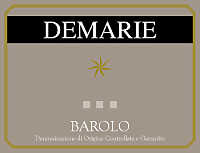
|
|
Barolo 2009 |
|
| Demarie (Piedmont, Italy) | |
| Grapes: Nebbiolo | |
| Price: € 27.00 | Score: |
| This Barolo shows a brilliant ruby red color and nuances of brick red, moderate transparency. The nose reveals intense, clean, pleasing and refined aromas which start with hints of cherry, plum and raspberry followed by aromas of dried violet, dried rose, vanilla, anise, mace, leather and menthol. The mouth has good correspondence to the nose, a tannic attack and however balanced by alcohol, full body, intense flavors, pleasing crispness. The finish is persistent with flavors of cherry, plum and raspberry. This Barolo ages for 2 years in cask. | |
| Food Match: Game, Roasted meat, Braised and stewed meat, Hard cheese | |

|
|
Roero Riserva 2008 |
|
| Demarie (Piedmont, Italy) | |
| Grapes: Nebbiolo | |
| Price: € 15.20 | Score: |
| This Roero Riserva shows a brilliant ruby red color and nuances of garnet red, moderate transparency. The nose denotes intense, clean, pleasing, refined and elegant aromas which start with hints of cherry, plum and dried violet followed by aromas of raspberry, rose, vanilla, tobacco, cocoa, blackberry, pink pepper and menthol. The mouth has good correspondence to the nose, a tannic attack and however balanced by alcohol, full body, intense flavors, pleasing crispness. The finish is persistent with flavors of cherry, raspberry and plum. This Roero Riserva ages for 12 months in cask and barrique followed by 12 months of aging in bottle. | |
| Food Match: Game, Roasted meat, Braised and stewed meat with mushrooms, Hard cheese | |
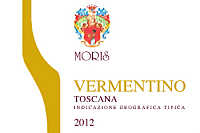
|
|
Vermentino 2012 |
|
| Moris Farms (Tuscany, Italy) | |
| Grapes: Vermentino | |
| Price: € 8.90 | Score: |
| This Vermentino shows a brilliant greenish yellow color and nuances of greenish yellow, very transparent. The nose denotes intense, clean, pleasing and refined aromas that start with hints of pear, pineapple and peach followed by aromas of apple, broom, chamomile, plum and almond. The mouth has good correspondence to the nose, a crisp attack and however balanced by alcohol, good body, intense flavors, agreeable. The finish is persistent with flavors of pear, pineapple and peach. This Vermentino ages in steel tanks. | |
| Food Match: Fried fish, Fish and crustacean appetizers, Sauteed fish, Pasta with fish | |
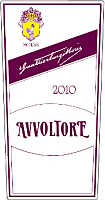
|
|
Avvoltore 2010 |
|
| Moris Farms (Tuscany, Italy) | |
| Grapes: Sangiovese (75%), Cabernet Sauvignon (20%), Syrah (5%) | |
| Price: € 33.00 | Score: |
| Avvoltore shows a deep ruby red color and nuances of ruby red, little transparency. The nose reveals intense, clean, pleasing, refined and elegant aromas which start with hints of black currant, black cherry and plum followed by aromas of violet, blueberry, vanilla, tobacco, pink pepper, cinnamon, chocolate, mace, tobacco and eucalyptus. The mouth has good correspondence to the nose, a tannic attack and however balanced by alcohol, full body, intense flavors, agreeable. The finish is very persistent with long flavors of black currant, black cherry and plum. Avvoltore ages for 12 months in barrique. | |
| Food Match: Game, Roasted meat, Braised and stewed meat, Hard cheese | |

|
|
Piemonte Albarossa Macchiaferro 2009 |
|
| L'Armangia (Piedmont, Italy) | |
| Grapes: Albarossa | |
| Price: € 11.50 | Score: |
| Piemonte Albarossa Macchiaferro shows an intense ruby red color and nuances of ruby red, little transparency. The nose denotes intense, clean, pleasing and refined aromas which start with hints of black cherry, plum and blackberry followed by aromas of blueberry, violet, black currant, vanilla, iris, mace and menthol. The mouth has good correspondence to the nose, a properly tannic attack and however balanced by alcohol, good body, intense flavors, pleasing crispness. The finish is persistent with flavors of black cherry, plum and blackberry. Piemonte Albarossa Macchiaferro ages in cask for 14 months. | |
| Food Match: Roasted meat, Stewed and braised meat with mushrooms, Roasted meat, Hard cheese | |

|
|
Barbera d'Asti Superiore Nizza Vignali 2007 |
|
| L'Armangia (Piedmont, Italy) | |
| Grapes: Barbera | |
| Price: € 24.00 | Score: |
| Barbera d'Asti Superiore Nizza Vignali shows an intense ruby red color and nuances of garnet red, little transparency. The nose denotes intense, clean, pleasing, refined and elegant aromas that start with hints of cherry, plum and blueberry followed by aromas of dried violet, raspberry, vanilla, mace, cocoa, tobacco, clover and menthol. The mouth has good correspondence to the nose, a properly tannic attack and however balanced by alcohol, good body, intense flavors, pleasing crispness and roundness. The finish is persistent with flavors of cherry, plum and blueberry. Barbera d'Asti Superiore Nizza Vignali ages for 12 months in cask and barrique followed by about 36 months in bottle. | |
| Food Match: Broiled meat and barbecue, Roasted meat, Stewed and braised meat, Hard cheese | |
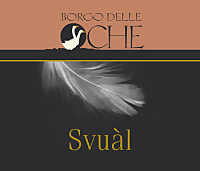
|
|
Svuàl 2007 |
|
| Borgo delle Oche (Friuli Venezia Giulia, Italy) | |
| Grapes: Merlot (70%), Cabernet Sauvignon (30%) | |
| Price: € 20.00 | Score: |
| Svuàl shows a deep ruby red color and nuances of garnet red, little transparency. The nose denotes intense, clean, pleasing, refined and elegant aromas which start with hints of black currant, plum and black cherry followed by aromas of violet, blueberry, blackberry, vanilla, tobacco, chocolate, pink pepper and eucalyptus. The mouth has good correspondence to the nose, a properly tannic attack and however balanced by alcohol, full body, intense flavors, pleasing roundness. The finish is persistent with flavors of black currant, plum and black cherry. Svuàl ages for 24 months in barrique. | |
| Food Match: Game, Roasted meat, Braised and stewed meat, Hard cheese | |
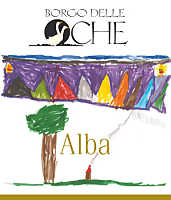
|
|
Alba 2011 |
|
| Borgo delle Oche (Friuli Venezia Giulia, Italy) | |
| Grapes: Gewürztraminer | |
| Price: € 30.00 - 500ml | Score: |
| Alba shows a brilliant amber yellow color and nuances of amber yellow, transparent. The nose reveals intense, clean, pleasing, refined and elegant aromas which start with hints of raisin, dried fig and honey followed by aromas of apricot jam, date, peach jam, lychee, quince jam, lavender, candied fruits, dried rose and nail polish. The mouth has good correspondence to the nose, a sweet and round attack, however balanced by alcohol, good body, intense flavors, pleasing crispness. The finish is persistent with flavors of raisin, dried fig and apricot jam. Alba ages in steel tanks. | |
| Food Match: Dried fruit tarts, Confectionery, Hard and piquant cheese | |
News |
|
In this section are published news and information about events concerning the world of wine and food. Whoever is interested in publishing this kind of information can send us a mail to our address.
|
Wine Parade |
|
|
| The best 15 wines according to DiWineTaste's readers. To express your best three wines send us an E-mail or fill in the form available at our WEB site. |
| Rank | Wine, Producer | |
|---|---|---|
| 1 |
| Camartina 2008, Querciabella |
| 2 |
| Brunello di Montalcino 2007, Donatella Cinelli Colombini |
| 3 |
| San Leonardo 2006, Tenuta San Leonardo |
| 4 |
| Verdicchio dei Castelli di Jesi Classico Superiore Podium 2010, Garofoli |
| 5 |
| Trento Brut Riserva Methius 2006, Dorigati |
| 6 |
| Amarone della Valpolicella Classico Capitel Monte Olmi 2007, Tedeschi |
| 7 |
| Avvoltore 2009, Moris Farms |
| 8 |
| Villa Gresti 2006, Tenuta San Leonardo |
| 9 |
| Trento Talento Brut Riserva 2007, Letrari |
| 10 |
| Langhe Riesling Herzu 2011, Ettore Germano |
| 11 |
| Confini 2007, Lis Neris |
| 12 |
| Franciacorta Pas Dosé Récemment Dégorgé 2006, Cavalleri |
| 13 |
| Brunello di Montalcino Vigna Loreto 2007, Mastrojanni |
| 14 |
| Sagrantino di Montefalco Collepiano 2007, Arnaldo Caprai |
| 15 |
| Offida Rosso Il Grifone 2006, Tenuta Cocci Grifoni |
| |||||||
Privacy Policy | |||||||


| Copyright © 2002-2024 Antonello Biancalana, DiWineTaste - All rights reserved |
| All rights reserved under international copyright conventions. No part of this publication and of this WEB site may be
reproduced or utilized in any form or by any means, electronic or mechanical, without permission in writing from DiWineTaste. |